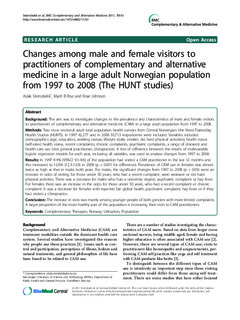| dc.contributor.author | Steinsbekk, Jan-Aslak | |
| dc.contributor.author | Rise, Marit By | |
| dc.contributor.author | Johnsen, Roar | |
| dc.date.accessioned | 2019-10-10T07:47:05Z | |
| dc.date.available | 2019-10-10T07:47:05Z | |
| dc.date.created | 2011-10-24T14:46:19Z | |
| dc.date.issued | 2011 | |
| dc.identifier.citation | BMC Complementary and Alternative Medicine. 2011, 11 (61), . | nb_NO |
| dc.identifier.issn | 1472-6882 | |
| dc.identifier.uri | http://hdl.handle.net/11250/2621320 | |
| dc.description.abstract | Background
The aim was to investigate changes in the prevalence and characteristics of male and female visitors to practitioners of complementary and alternative medicine (CAM) in a large adult population from 1997 to 2008.
Methods
Two cross sectional adult total population health surveys from Central Norwegian (the Nord-Trøndelag Health Studies (HUNT)). In 1997 42,277 and in 2008 50,713 respondents were included. Variables included demographics (age, education, working status), lifestyle (daily smoker, did hard physical activities), health status (self-rated health status, recent complaints, chronic complaints, psychiatric complaints, a range of diseases) and health care use (visit general practitioner, chiropractor). A test of difference between the results of multivariable logistic regression models for each year, including all variables, was used to analyse changes from 1997 to 2008.
Results
In 1997 9.4% (95%CI 9.1-9.6) of the population had visited a CAM practitioner in the last 12 months and this increased to 12.6% (12.3-12.9) in 2008 (p < 0.001 for difference). Prevalence of CAM use in females was almost twice as high as that in males both years. For males, the significant changes from 1997 to 2008 (p < 0.05) were an increase in odds of visiting for those under 50 years, who had a recent complaint, were widower or did hard physical activities. There was a decrease for males who had a university degree, psychiatric complaint or hay fever. For females there was an increase in the odds for those under 50 years, who had a recent complaint or chronic complaint. It was a decrease for females with reported fair global health, psychiatric complaint, hay fever or if they had visited a chiropractor.
Conclusion
The increase in visits was mainly among younger people of both genders with more limited complaints. A larger proportion of the more healthy part of the population is increasing their visits to CAM practitioners. | nb_NO |
| dc.language.iso | eng | nb_NO |
| dc.publisher | BMC (part of Springer Nature) | nb_NO |
| dc.rights | Navngivelse 4.0 Internasjonal | * |
| dc.rights.uri | http://creativecommons.org/licenses/by/4.0/deed.no | * |
| dc.title | Changes among male and female visitors to practitioners of complementary and alternative medicine in a large adult Norwegian population from 1997 to 2008 (The HUNT studies) | nb_NO |
| dc.type | Journal article | nb_NO |
| dc.type | Peer reviewed | nb_NO |
| dc.description.version | publishedVersion | nb_NO |
| dc.source.pagenumber | 9 | nb_NO |
| dc.source.volume | 11 | nb_NO |
| dc.source.journal | BMC Complementary and Alternative Medicine | nb_NO |
| dc.source.issue | 61 | nb_NO |
| dc.identifier.doi | 10.1186/1472-6882-11-61 | |
| dc.identifier.cristin | 847522 | |
| dc.description.localcode | © 2011 Steinsbekk et al; licensee BioMed Central Ltd. This is an Open Access article distributed under the terms of the Creative Commons Attribution License (http://creativecommons.org/licenses/by/2.0), which permits unrestricted use, distribution, and reproduction in any medium, provided the original work is properly cited. | nb_NO |
| cristin.unitcode | 194,65,20,0 | |
| cristin.unitname | Institutt for samfunnsmedisin og sykepleie | |
| cristin.ispublished | true | |
| cristin.fulltext | original | |
| cristin.qualitycode | 2 | |

